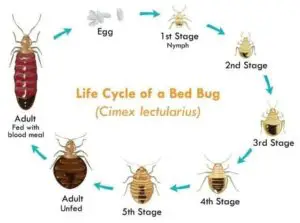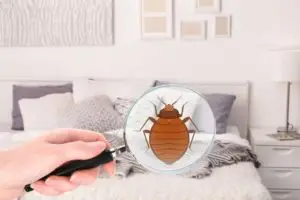Ugh… bed bugs. A bed bug infestation is the single most terrifying fear of my adult life. Since bed bug exterminators can cost hundreds of dollars, figuring out how to kill bed bugs on a low income budget can be overwhelming and oh-so-frustrating.
Of course, we’ve done some investigating and we’ve found help. In addition to searching out the best bed bug killer, we’ve also dug into your state laws to see if there’s any relief for low income tenants.
When you’re dealing with bed bugs, you have too much going on to worry about taking a trip to the store. Most stores don’t have a great selection of bed bug killers, anyway! In addition to their great selection and fast free shipping, Amazon Prime offers discounts and free trials for several typically low income demographics, including food stamps (EBT) users, Medicaid recipients, college students, families and others. Shopping on Amazon just makes this process so much easier.
What is a bed bug?
Bed bugs are parasites that feed on human blood. They cause itchy bites and can be very difficult to exterminate.
Although they aren’t known to transmit any diseases, some people do have allergic reactions to their bites. Secondary infections from the bite can also cause complications. Anxiety, insomnia and similar mental health side effects have also been reported.
Adult bed bugs are generally the same size and shape as an apple seed. If they haven’t fed recently, they have a flat, oval-shaped body. If they have sucked blood recently, they will swell up into a longer, reddish-brown balloon shape. Nasty, right?

Where do bed bugs come from?
Bed bugs are hitchhikers. They travel on furniture, bedding, luggage, boxes and clothing. They only eat every 5-10 days and can survive months without feeding. Some research shows they can go up to a YEAR between meals! They are extremely resilient, which makes them very difficult to eliminate.
It is a common myth that bed bugs are attracted to filth and grime. This is not the case. Although clutter does provide them with more hiding places, bed bugs are attracted to heat, blood and carbon dioxide. Basically, they’re just attracted to human bodies.
Unfortunately, this means that thrifty families who rely on secondhand clothing, furniture and other items are especially at risk for bed bug infestations. Low income families are more likely to rely on laundromats, apartment laundry machines and other shared laundry facilities, which also increase the risk of bed bug infestations.

Can you see bed bugs?
Yes, you can. They are about the same size and shape of an apple seed. Even the eggs are roughly the size of a pinhead, which can be visible to the eye.
How can you prevent bed bugs?
Here are some great tips for preventing bed bugs from entering your home:
- Always check any secondhand items that you buy or receive for bed bugs.
- Use protective covers for mattresses and box springs. Use an encasement that is light colored and resistant to tearing.
- Reduce clutter in your home to eliminate hiding places.
- Be mindful when you are away from home. Don’t set your purse or jacket on the floor or in empty upholstered seats.
- Vacuum frequently.
If you live in an apartment or shared housing situation, you will need to be even more careful. Install door sweeps on the bottom of your doors so that bed bugs in the hallway don’t slip into your home. Seal cracks and crevices around baseboards, light sockets and other crevices to prevent them from slipping through cracks.
Be very careful in shared laundry facilities. Transport items in plastic bags. When you remove items from the dryer, place them directly in a plastic bag and fold them at home.
How to Kill Bed Bugs
Of course, the most effective way to eradicate an infestation is with a bed bug exterminator. Most low income households can’t afford such an expensive service, so we’ve found a few effective strategies for you.
You will have to be very deliberate in your eradication efforts. Bed bug eggs are resistant to most forms of treatment, so you will probably need to try multiple approaches. In fact, the EPA states that you will have to use an Integrated Pest Manamgenet (IPM) approach in order to fully eradicate these pests.
The EPA warns that it can take weeks or even months to fully eradicate an infestation. If you live in an apartment complex with many neighbors, you will need to involve your landlord in order to successfully eradicate the infestation. Fortunately, many states require landlords to control these pests. More info on that in the state-specific list below!

Step One: Identify the Problem
If you’re focusing on how to kill bed bugs, the first step is to confirm that you actually have bed bugs. There are many different insects, including fleas, ticks, carpet beetles and lice, that confused for bed bugs. Fortunately, these other inspects are much easier to eliminate!
In order to be sure they are bed bugs, you can collect a sample for an entomology expert at the National Pesticide Information Center Extension Service. There are extension offices in most US counties.
If you are confirmed to have bed bugs, you will need to notify your landlord immediately so that the surrounding apartments can be inspected and treated. If all residents aren’t working on it at the same time, it will be impossible to fully and permanently eradicate the pests.
You should keep diligent records about your extermination efforts. Use a calendar or journal to take notes about where the pests were found and what you did to eliminate them. Keep your records! You will need to continue monitoring for several months to ensure that the infestation is truly eliminated.
Step Two: Stop them from Spreading
As stated above, bed bugs are notorious hitchhikers. Preventing the spread of bed bugs takes a lot of effort!
Although you probably want to skip right to treatment, the EPA warns, “Jumping straight into control is tempting, but won’t work. Preparing for treatment is essential to getting successful control.”
Isolate your mattress immediately.
Mattresses can be secured inside a bed bug encasement. These specialized mattress covers prevent bed bugs from reaching you and should be left in place for at least one year.
Remove clutter and any items that cannot be cleaned.
You will need to clean up any clutter inside your home. Bed bugs love clutter, because it provides ample hiding places – especially during treatment periods! Trying to eradicate the bugs while clutter is present would be a waste of time and money, so be sure to tackle the clutter responsibly before you begin treatment.
Use sealed plastic bags to isolate items from the infected room. These items should be left for an extended period of time to ensure that any active bugs are dead. Some research indicates that it may take up to a year to ensure that the pests are dead.
Furniture that cannot be thoroughly cleaned must be discarded. The EPA recommends destroying the furniture so that nobody else is tempted to take it. They even suggest using spray paint to write “bed bugs” on the furniture!
Vacuum and heat-treat often.
You will need to regularly wash and heat-dry your bed sheets, blankets, bedspreads and any clothing that touches the floor. Be sure to clean any hampers or clothing storage containers regularly, since bed bugs can hide in those, too!
Vacuum often. Vacuum your floors, furniture, rugs, bed frames, mattresses and all cracks and crevices of your home. Vacuum from the outside of the room to the inside. Move and vacuum under the furniture.
Empty the vacuum into a Ziploc bag after each use. Seal the bag immediately to prevent any captured bugs from escaping. Throw it in an outdoor trash container as soon as possible.
Step Three: Kill the Bed Bugs
DO NOT SKIP STEP TWO. The EPA warns, “Jumping straight into control is tempting, but won’t work. Preparing for treatment is essential to getting successful control.”
There are several different approaches regarding how to kill bed bugs. Some people prefer bed bug heat treatment or cold treatment. Others seek out the best bed bug killers. Even bed bug exterminators can be ineffective sometimes.
Bed Bug Heat Treatment & Cold Treatment
Bed bugs cannot survive extreme temperatures.
Many people are familiar with bed bug heat treatment options, which require you to place fabrics in the clothes dryer on high heat for 90 minutes or more. Others stuff fabrics in black plastic bags, which they leave in the sunshine or in hot, closed cars. The bugs will die when their internal temperatures reach 113 degrees Fahrenheit.
Some people also use cold treatments by storing belongings in their freezers for at least four days. However, the EPA warns that this may not be effective because many home freezers do not get cold enough to kill bed bugs. They recommend using a thermometer to ensure that your cold treatment is effective.
Affordable or natural DIY bed bug killers can help.
There are several popular and effective DIY bed bug killers available to consumers. These include diatomaceous earth and cold-pressed neem oil.
Diatomaceous earth (DE) is a crumbly powder made from the fossil remains of diatoms, which are tiny aquatic organisms. Diatomaceous earth is a dessicant, which means that it destroys the protective outer coating of a bed bug’s exoskeleton. When the coating is removed, the bed bugs will slowly dehydrate and die. Because of this effect, bed bugs cannot develop a resistance to diatomaceous earth.
When purchasing diatomaceous earth, it is important to purchase the type that is registered by the EPA for bed bug control. Other types, such as the kind designed for use in swimming pools, can cause damage when inhaled by humans. Be sure to only place diatomaceous earth in cracks and crevices, where it does not pose an inhalation risk.
Amazon has some very affordable diatomaceous earth. You can find large quantities from Safer Brand and Harris.
Cold-pressed neem oil is a biochemical derived from the seeds of the tropical evergreen Neem tree of Africa and Southeast Asia. This oil has proven effective at controlling bed bugs, including nymphs and eggs. Amazon sells it in bulk sizes of 16 oz to 32 oz!
Essential oils are often touted as being effective against bed bugs. However, the EPA states that neem oil is “the only biochemical pesticide registered for use against bed bugs.” A study cited by Wired.com also shows that essential oils failed to kill or affect bed bugs when isolated in a petri dish. Please do not spend your money on an ineffective solution!
Insecticides are often considered the best bed bug killer.
The EPA regulates insecticides and has currently approved over 300 products for use against bed bugs. It is important to realize that it is illegal to use an insecticide in any way other than described in the instructions.
Unfortunately, many treatments fail to fully contain a bed bug infestation. Treatments can fail for many reasons, including a failure to find all bed bugs, failing to prepare the area, and failing to treat nearby areas where the bugs may have migrated (such as an adjacent apartment).
There are seven primary types of pesticides that are used for bed bug control. Of course, these seven categories all kill bed bugs in different ways. These categories are:
- Pyrethins
- Pyrethroids
- Desiccants
- Biochemicals
- Pyrroles
- Neonicotinoids
- Insect Growth Regulators
Bed bugs in the United States are known to be resistant to pyrethroids, the main chemical class in many foggers and other consumer products. Don’t assume that more is better! Many people have blown out their windows or caused other damage because they used more foggers than recommended at one time.
To maximize the effectiveness of your treatments, you will need to use various pesticides. Try not to use the same type twice in a row. The EPA has a helpful pesticide search tool that can help you find the right product for your needs.
Your best bet is a bed bug exterminator.
Bed bug exterminators have special tools that the average person cannot use. For example, they can use a whole room heat treatment that raises the temperature of your entire home to a lethal level that will eliminate all the bed bugs in all their stages. They also have access to chemical fumigation methods that are not available to regular consumers.
Bed bug exterminators like Terminix use tools for bed bug heat treatment, steam treatments and more. Their specialized tools and training ensure that their methods are more effective and comprehensive than the treatments you can on your own.
When you are hiring a bed bug exterminator, be sure to ask the manager (not the technician or salesman) these questions:
- How many bed bug jobs did they do last year? Ask for references.
- Are they familiar with Integrated Pest Management?
- What chemical and non-chemical products do you use?
- What is their protocol for follow-up?
Can’t afford a bed bug exterminator? We found help!
Bed bug exterminators can be insanely expensive. Fortunately, if you are renting, you may be protected by state laws that require your landlord to cover this expense. Click the link below to find out if your state requires your landlord to pay for a bed bug exterminator!

